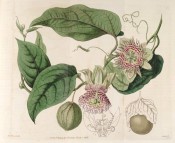Passiflora maliformis L.
Perennial climber with entire leaves fragrant, white, red and violet flowers, followed by yellowish-green edible fruit. [RHSD, Hortus].
Horticultural & Botanical History
‘The fruit is said to form a principle part of the food of the wild swine. It is also used as a dessert, the pulp possessing a subacid flavour grateful in hot climates. The hard shell-like rind is dried, and manufactured in the French colonies into snuff boxes, bonbonières, and other toys, such as we sometimes see formed of the peel of Lemons or of Limes.’ [BR f.94/1816.] Introduced from the West Indies in 1731. [JD].
History at Camden Park
Desideratum to Loddiges’ Nursery on 6th January 1845 [MP A2933-2, p.28]. I have found no further records and it may never have been grown at Camden.
Notes
Passiflora maliformis Vell. (1831) = Passiflora alata C.Curtis. which see.
Published Jan 31, 2010 - 04:32 PM | Last updated Jul 29, 2010 - 02:52 PM
| Family | Passifloraceae |
|---|---|
| Category | |
| Region of origin | Carribean |
| Synonyms | |
| Common Name | |
| Name in the Camden Park Record |
Passiflora maliformis |
| Confidence level | high |
